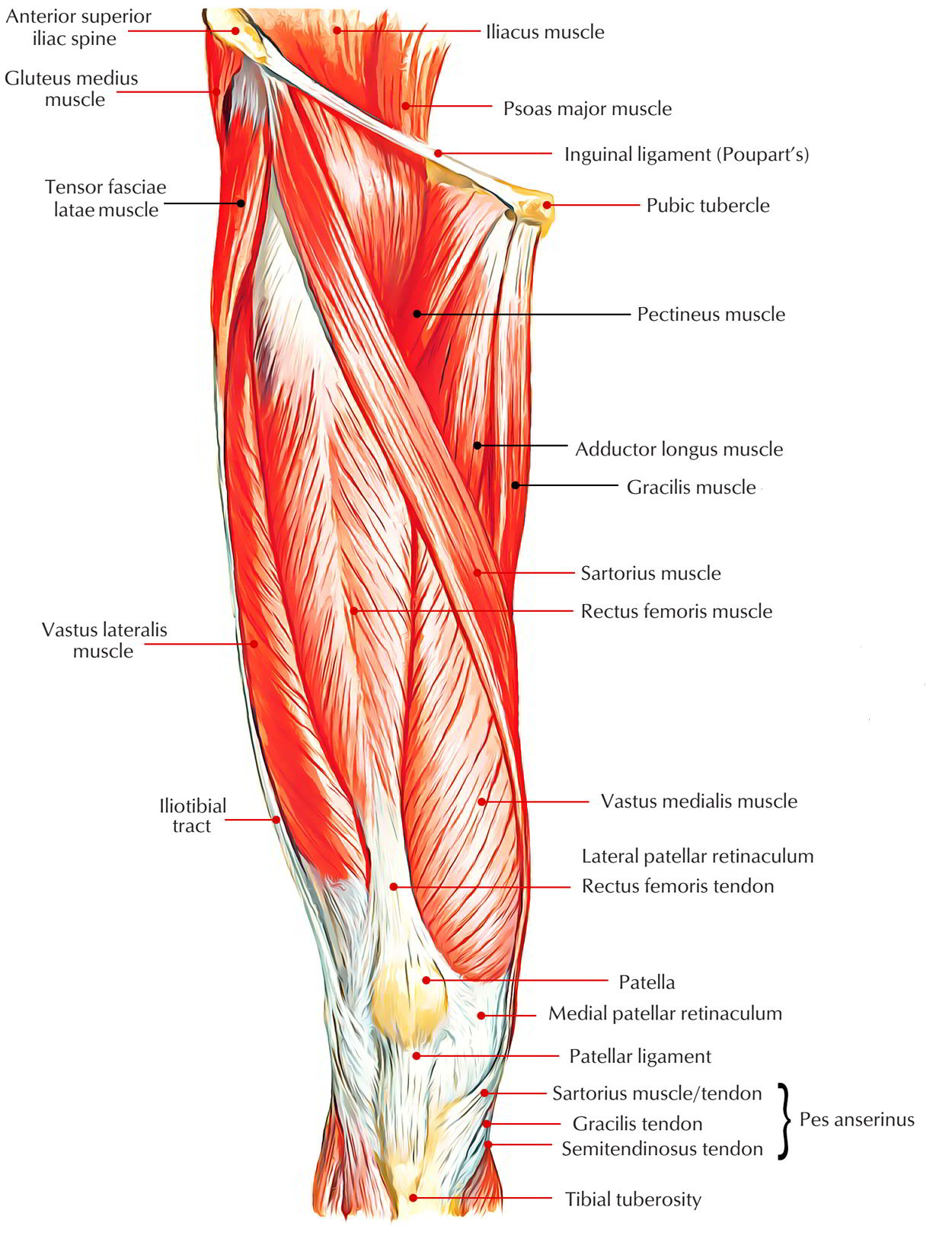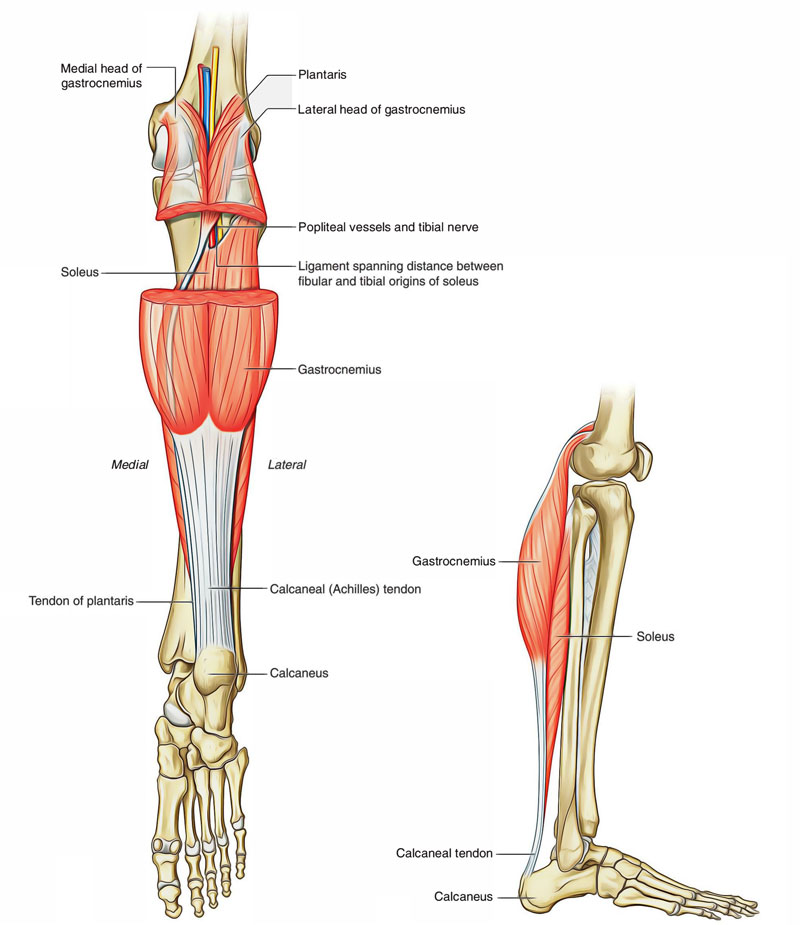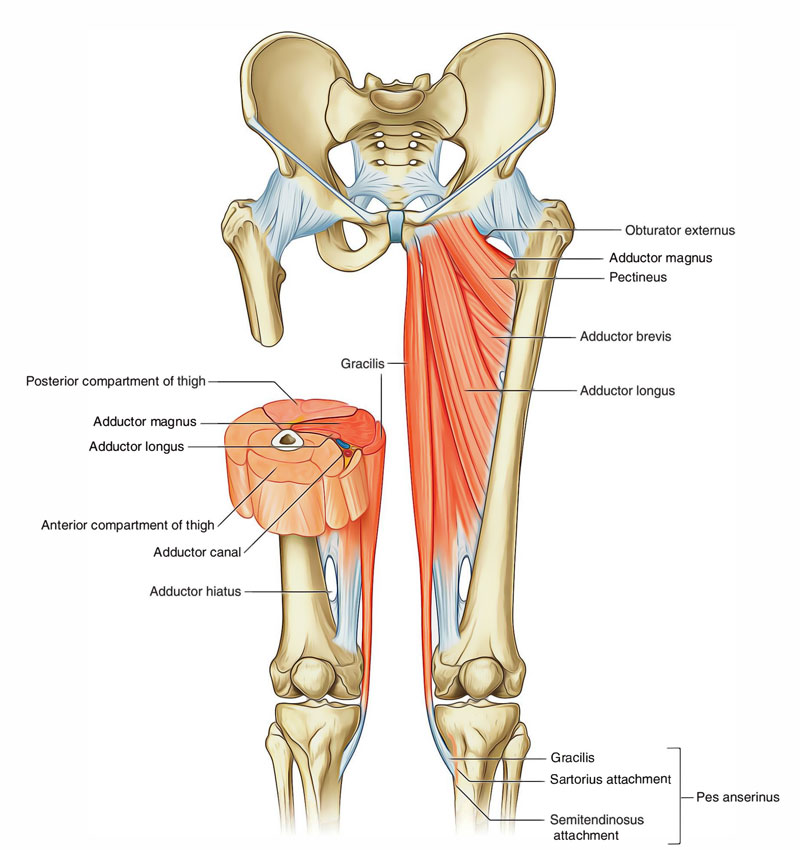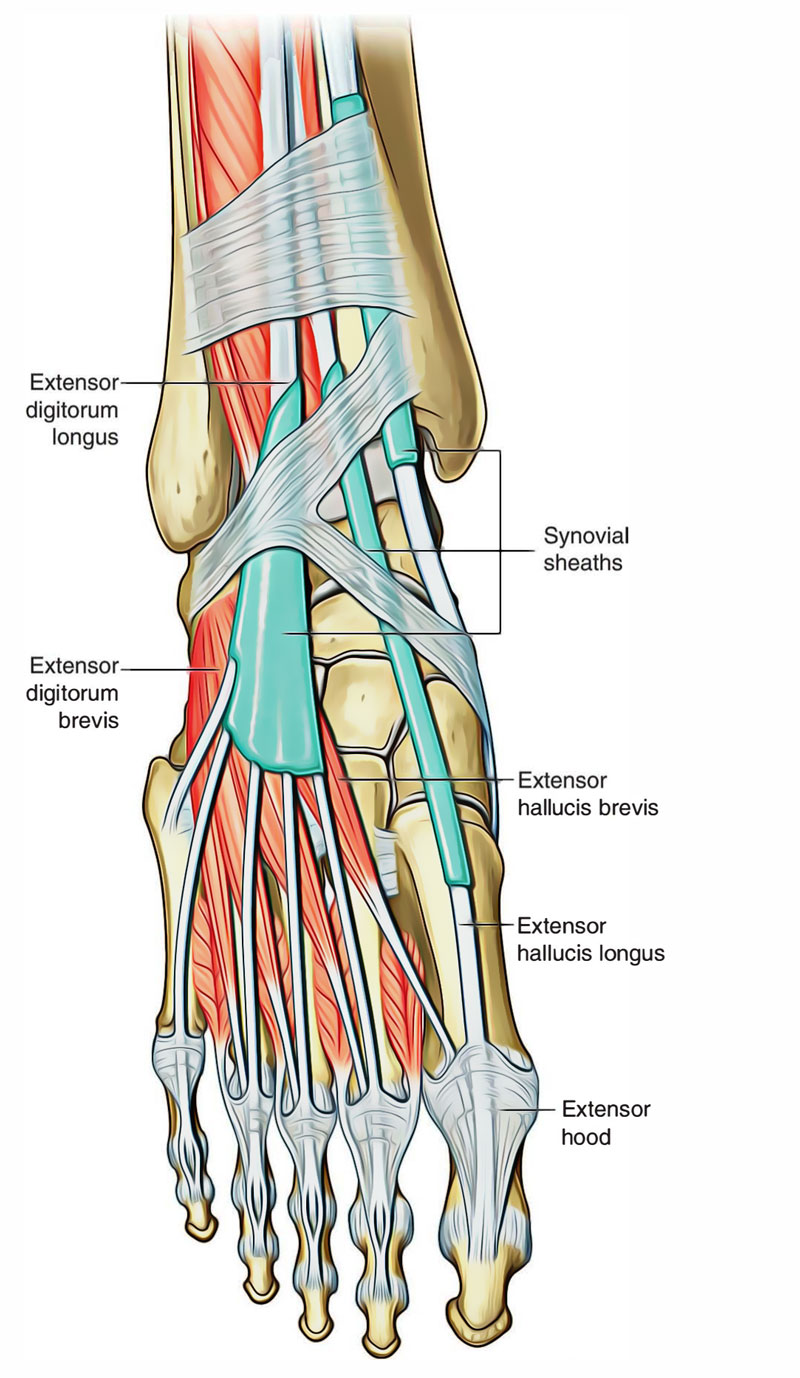Muscles of the leg include muscles of the thigh and foot. Leg muscles functions to perform all the motions and movements of the lower limb like standing, running, dancing etc. Leg muscles can be divided into 3 compartments: Anterior compartment, posterior compartment and lateral compartment.
Muscles of the Anterior Compartment of the Leg
Some of the major muscles of anterior compartment of the leg are:
- Quadriceps femoris
- Articularis genu
- Sartorius
- Tensor fasciae latae
- Tibialis anterior
- Extensor hallucis longus
- Extensor digitorum longus
- Peroneus tertius

Leg Muscles: Muscles of the Anterior Compartment of the Leg
Quadriceps Femoris
Quadricep femoris is thus referred to as because it is composed of 4 mucles: rectus femoris, vastus lateralis, vastus medialis, and vastus intermedius. It’s supplied by the femoral nerve. It creates the majority of the mass on the anterior aspect of the thigh and is the strongest extensor of the knee joint.
All the parts of quadriceps cross only 1 joint, i.e., knee joint, with the exception of rectus femoris which crosses 2 joints, i.e., hip and knee joints.
Articularis Genu
Originates from the anterior surface of the lower part of the shaft of the femur, few centimeters above the patellar articular margin. Articularis genu is made up of 3 or 4 muscular skids that are said to be a separated part of the vastus intermedius.
Sartorius
Sarotius muscle corkscrew obliquely through the thigh from lateral to medial side to reach the posterior aspect of the medial condyle of femur. Sartorius muscle appears from the anterior superior iliac spine and upper half of the notch immediately below it.
Tensor Fasciae Latae
It is a thick short muscle and is located at the junction of the gluteal region at the upper part of the front of the thigh. It abducts the hip joint and keeps the extended position of the knee joint via the iliotibial tract.
Tibialis Anterior
It is a spindle-shaped multipennate muscle. Tibialis anterior is the most medial and superficial dorsiflexor of the foot, which is located against the lateral surface of the tibia. The muscle fibres converge below to create a tendon that is related to the lower 1/3rd of the lateral surface of the tibia. It is innervated by the deep peroneal nerve.
Extensor Hallucis Longus
Extensor halluces longus muscle originates from the middle 2/4th (posterior part) of the medial surface of the shaft of fibula. It performs the extension of the phalanges of the big toe and dorsiflexion of the foot.
Extensor Digitorum Longus
The extensor digitorum longus muscle is the most posterior together with lateral of the muscles in the front compartment of the leg. Just like the tibialis anterior muscle, it also emerges via deep fascia. It performs the extension of MP, PIP, and DIP joints of the lateral four toes.
Peroneus Tertius
Peroneus tertius originates from the lower 1/4th of the anterior surface of the fibula. It is inserted into the dorsal surface (medial part) of the base of the 5th metatarsal bone. Peroneus tertius also perform dorsiflexion of the foot.
Muscles of the Posterior Compartment of the Leg
Some of the major muscles of posterior compartment of the leg are:
- Hamstring
- Superficial muscles of the posterior compartment of the leg:
- Gastrocnemius
- Soleus
- Plantaris
- Deep muscles of the posterior compartment of the leg:
- Popliteus
- Flexor digitorum longus
- Flexor hallucis longus

Leg Muscles: Muscles of the Posterior Compartment of the Leg
Hamstring
These muscles on the back of the thigh are termed the hamstring muscles (Latin ham = back of thigh). Yet conventionally the short head of the biceps femoris isn’t incorporated in the hamstring group. All the hamstrings muscles are:
| Muscle | Origin | Insertion | Nerve supply |
|---|---|---|---|
| Biceps femoris (a) Long head | (a) Long head: From lower medial part of upper quadrilateral area of ischial tuberosity | Into the head of the fibula in front of its styloid process | (a) Long head, by the tibial part of the sciatic nerve (L5; S1, S2) |
| (b) Short head | (b) Short head: From lateral lip of the linea aspera and from the upper two-third of the lateral supracondylar line | (b) Short head by the common peroneal part of the sciatic nerve (L5; S1, S2) | |
| Semitendinosus | From the lower medial part of upper quadrilateral area of the ischial tuberosity, | Into the upper part of the medial surface of the tibia | Tibial part of the sciatic nerve (L5; S1, S2) |
| Semimembranosus | From the upper lateral part of upper quadrilateral area of ischial tuberosity | Into the horizontal groove on the posterior aspect of the medial condyle of the tibia | Tibial part of the sciatic nerve (L5; S1, S2) |
| Ischial part of adductor magnus | From inferolateral aspect of the ischial tuberosity | Into the adductor tubercle | Tibial part of the sciatic nerve (L5; S1, S2) |
Superficial Muscles of the Posterior Compartment of the Leg
The superfcial group of muscles in the posterior compartment of the leg comprises three muscles-the gastrocnemius, plantaris, and soleus, all of which insert onto the heel (calcaneus) of the foot and plantarflex the foot at the ankle joint.
Gastrocnemius
It is the largest and most superficial muscle of the posterior compartment. It includes 2 heads- medial and lateral. Gastrocnemius muscle is the main plantar flexor of the foot in the ankle when the knee is extended and it is also a flexor of the knee.
Soleus
It’s a multipennate muscle being located deep to the gastrocnemius and is supplied by 2 branches of the tibial nerve. The tendon of soleus fuses with that of gastrocnemius to create tendocalcaneus, that is added into the middle 1/3rd of the posterior surface of calcaneum.
Plantaris
The Plantaris muscle appears from the lower 1/3rd of the lateral supracondylar line and the adjoining part of the oblique popliteal ligament. It’s a small muscle with a short gut and long slim tendon. It is located between the gastrocnemius and soleus.
Deep Muscles of the Posterior Compartment of the Leg
There are four muscles in the deep posterior compartment of the leg – the popliteus, flexor hallucis longus, flexor digitorum longus, and tibialis posterior.
Popliteus
It’s a thin, flat, triangular muscle, which forms the inferior part of the floor of the popliteal fossa. It unlocks the locked knee by rotating the femur laterally during first phases of flexion of the knee.
Flexor Digitorum Longus
The flexor digitorum longus flexes the lateral four toes. It originates on the medial side of the posterior compartment of the leg and inserts into the lateral four digits of the foot. It is involved with gripping the ground during walking and propelling the body forward off the toes at the end of the stance phase of gait. It is innervated by the tibial nerve.
Flexor Hallucis Longus
The flexor hallucis longus muscle originates on the lateral side of the posterior compartment of the leg and inserts into the plantar surface of the great toe. The flexor hallucis longus flexes the great toe.
Muscles of the Lateral Compartment of the Leg
Muscles of the lateral compartment of the leg are:
| Muscles | Origin | Insertion | Nerve supply | Actions |
|---|---|---|---|---|
| Peroneus longus (larger and lies superficial to the peroneus brevis) | 1. Upper 2/3rd of the lateral surface of the fibula 2. Adjoining surface of the lateral condyle of the tibia 3. Anterior and posterior intermuscular septa | 1. Lateral side of the base of the 1st metatarsal 2. Adjoining part of the medial cuneiform | Superficial peroneal nerve (L5; S1, S2) | 1. Eversion of the foot 2. Weak plantar flexion of the ankle 3. Maintains the lateral longitudinal arch |
| Peroneus brevis (smaller and lies deep to the peroneus longus) | 1. Lower 2/3rd of the lateral surface of the fibula 2. Anterior and posterior intermuscular septa | Lateral side of the base of the 5th metatarsal bone | Superficial peroneal nerve (L5; S1, S2) | 1. Eversion of the foot 2. Weak plantar flexion of the ankle 3. Maintains the lateral longitudinal arch |
Muscles of the Medial Compartment of the Thigh
The muscles of the medial compartment of the thigh are ordered into 3 layers:
- Anterior (first) layer is composed of pectineus, adductor longus, and gracilis.
- Middle (second) layer contains adductor brevis.
- Posterior (third) layer is composed of adductor magnus.

Leg Muscles: Muscles of the Medial Compartment of the Thigh
| Muscle | Origin | Insertion | Nerve supply | Actions |
|---|---|---|---|---|
| Pectineus (flat, quadrilateral muscle, composite muscle) | 1. Pecten pubis 2. Upper half of the pectineal surface of the superior ramus of the pubis 3. Fascia covering the pectineus | Line extending from the lesser trochanter to the linea aspera | Femoral nerve and anterior division of the obturator nerve | Adduction of the thigh |
| Adductor longus (triangular muscle, forming the medial part of the floor of the femoral triangle) | Body of the pubis in the angle between the pubic crest and the pubic symphysis | Middle 1/3rd of linea aspera | Obturator nerve (anterior division) | Adduction and medial rotation of thigh |
| Adductor brevis (triangular muscle lying behind the pectineus and adductor longus) | 1. Anterior surface of the body of pubis 2. Outer surface of the inferior ramus of the pubis between the gracilis and the obturator externus | Line extending from the lesser trochanter to the linea aspera, and upper part of the linea aspera itself just lateral to pectineus | Obturator nerve (anterior and posterior divisions) | Adduction of thigh |
| Adductor magnus (large composite) | (a) Hamstring part: inferolateral part of the ischial tuberosity (b) Adductor part: outer part of the ischiopubic ramus | 1. Medial margin of gluteal tuberosity 2. Linea aspera 3. Medial supracondylar line 4. Adductor tubercle | 1.Adductor part by the obturator nerve (posterior division) 2. Hamstring part by the tibial part of sciatic nerve | 1. Adduction and medial rotation of thigh 2. Weak extension of hip joint |
| Gracilis | Medial margin of the lower half of the body of the pubis: adjoining anterior part of inferior ramus of the pubis | Upper part of the medial surface of tibia between the insertions of sartorius (in front) and the semitendinosus (behind) | Obturator nerve (anterior division) | 1. Adduction of thigh 2. Flexion and medial rotation of leg |
Muscles of the Foot
The muscles of the foot mainly customize and improve the actions of the long tendons and help fine movements of the toes.
Muscles of the Dorsum of the Foot
Extensor Digitorum Brevis
It’s a small muscle situated on the lateral part of the dorsum of the foot, deep to the tendons of extensor digitorum longus. It’s the only muscle on the dorsum of the foot and creates a fleshy swelling anterior to the lateral malleolus.

Leg Muscles: Muscles of the Dorsum of the Foot
Extensor Hallucis Brevis
The extensor hallucis brevis originates in conjunction with the extensor digitorum brevis. Its tendon attaches to the base of the proximal phalanx of the great toes. The muscle extends the metatarsophalangeal joint of the great toe and is innervated by the deep fibular nerve.
Muscles of the Sole of the Foot
| Muscles | Origin | Belly/Tendon | Insertion | Nerve supply | Actions |
|---|---|---|---|---|---|
| • Flexor digitorum brevis (resembles flexor digitorum superficialis of the hand) | Medial tubercle of the calcaneum | 1.It forms 4 tendons for the lateral 4 toes. 2.Each tendon splits into two slips opposite the bases of proximal phalanges to allow passage of the long flexor tendon | Margins of the middle phalanges of lateral 4 toes | Medial plantar nerve (S2, S3) | Flexor of the lateral toes |
| • Abductor hallucis (lies along the medial border of the foot) | 1. Medial tubercle of the calcaneum. 2. Flexor retinaculum. | Its tendon fuses with medial portion of the tendon of flexor hallucis brevis for a common insertion | Medial side of the base of proximal phalanx of the big toe | Medial plantar nerve (S2, S3) | Flexion and abduction of the big toe |
| • Abductor digiti minimi (lies along the lateral border of the foot) | Medial and lateral tubercles of the calcaneum in a continuous line | Its tendon fuses with the tendon of flexor digiti minimi brevis for a common insertion | Lateral side of the base of proximal phalanx of the little toe | Lateral plantar nerve (S2, S3) | Flexion and abduction of the little toe |
| • Flexor digitorum accessorius | By two heads: 1. Medial head from the medial concave surface of the calcaneum and adjoining part of the medial tubercle. 2. Lateral head from the calcaneum in front of the lateral tubercle | The two heads unite at an acute angle | Tendon of the flexor digitorum longus (FDL) | Lateral plantar nerve (S2, S3) | 1. Straightens the pull of the long flexor tendons. 2. Assists the flexor digitorum longus in flexing the lateral 4 toes |
| • Lumbricals (4 in number and numbered from medial to lateral side) Tendon of flexor digitorum longus Tendon of flexor hallucis longus | From the tendons of the flexor digitorum longus | Tendons pass forwards on the medial sides of the metatarso-phalangeal joints of the lateral four toes | Into the extensor expansions and bases of proximal phalanges of lateral 4 toes | 1st by the medial plantar nerve, and 2nd, 3rd, and 4th by the lateral plantar nerve (S2, S3) | Extension of toes at the interphalangeal joints |
| Third Layer | |||||
| • Flexor hallucis brevis | It arises by a Y-shaped tendon: 1.Lateral limb from the medial part of the plantar surface of the cuboid bone. 2.Medial limb from the lateral cuneiform | Muscle belly splits in two parts. Each part gives rise to a tendon which contains a sesamoid bone near its insertion. The medial tendon blends with the abductor hallucis, and the lateral tendon blends with the adductor hallucis | Each side of the base of proximal phalanx of the big toe (1st digit) | Medial plantar nerve (S2, S3) | Flexion of the proximal phalanx of big toe |
| • Flexor digiti minimi brevis | Base of the 5th metatarsal bone | Forms narrow tendon which blends with the abductor digiti minimi | By a narrow tendon into the lateral side of the base of proximal phalanx of the little toe | Superficial branch of the lateral plantar nerve (S2, S3) | Flexes the proximal phalanx of the little toe |
| • Adductor hallucis | It arises by two heads: 1.Large oblique head from bases of the 2nd, 3rd, and 4th metatarsals. 2.Small transverse head from the plantar ligaments of the metatarso-phalangeal joints of 3rd, 4th, and 5th toes | The common tendon of both heads fuses with the lateral tendon of the flexor hallucis brevis | By the composite tendon on the lateral side of the base of proximal phalanx of the big toe | Deep branch of the lateral plantar nerve (S2, S3) | 1.Adduction of the big toe .2Maintains transverse arches of the foot. |
| • Dorsal interossei * (4 in number, and lies between the metatarsal bones) | They are bipennate and arises from the adjacent sides of the metatarsal bones (1-5) | Tendons are arranged on the abductor sides of the toes | 1.1st on the medial side of the proximal phalanx of 2nd digit. 2nd-4th on the lateral sides of 2nd-4th digits | Lateral plantar nerve (S2, S3) | 1.Abducts digits (2nd-4th). 2. Flexes the metatarso-phalangeal joints. |
| Plantar interossei * (3 in number and lies rather below the metatarsals) | They are unipennate and arises from the medial sides of the metatarsal bones (3rd-5th) | Tendons are arranged on the adductor sides of the toes | Medial sides of bases of the phalanges of 3rd-5th digits | Lateral plantar nerve (S2, S3) | 1.Adducts the digits (2nd-4th). 2.Flexes the metatarso-phalangeal joints |
